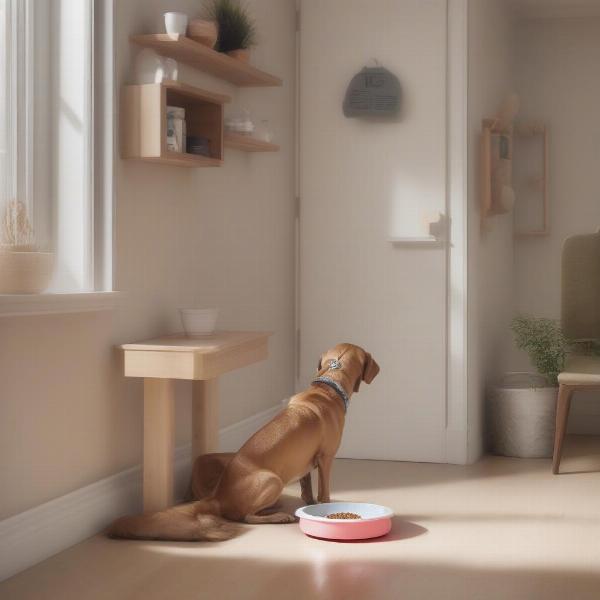Finding the perfect dog food bowl and water setup might seem simple, but it’s an important aspect of your dog’s health and happiness. From material and size to placement and special needs, the right dog food bowl and water can significantly impact your furry friend’s eating habits and overall well-being. This guide will explore the key factors to consider when selecting the ideal dog food bowl and water for your canine companion.
Materials Matter: Exploring Dog Food Bowl Options
Choosing the right material for your dog’s food and water bowls is crucial for their health. Each material has its pros and cons, catering to different needs and preferences.
-
Stainless Steel: Durable, hygienic, and dishwasher-safe, stainless steel is a popular choice. It’s also resistant to rust and bacteria, making it a healthy option.
-
Ceramic: Often aesthetically pleasing, ceramic bowls are heavy and less likely to tip over. However, they can chip or crack, and some glazes may contain lead, so choose wisely.
-
Plastic: While lightweight and inexpensive, plastic bowls can be easily chewed or scratched, harboring bacteria. Opt for BPA-free plastic if you choose this option.
-
Elevated Bowls: Raised bowls can be beneficial for larger breeds or dogs with arthritis, promoting better posture while eating. They are available in various materials, including stainless steel and plastic.
Sizing Up: Finding the Right Fit for Your Dog
The size of your dog’s food and water bowls should correspond to their breed and eating habits. A small bowl for a large dog will lead to frequent refills and potential frustration, while a large bowl for a small dog can be overwhelming. Consider your dog’s food intake and water consumption when selecting the appropriate size.
Placement is Key: Where to Put Your Dog’s Bowls
Where you place your dog’s food and water bowls can impact their comfort and eating habits. A quiet, accessible area away from high-traffic zones is ideal. For multi-dog households, separate feeding areas can minimize competition and stress.
 Proper Dog Food and Water Bowl Placement
Proper Dog Food and Water Bowl Placement
Special Considerations: Catering to Your Dog’s Unique Needs
Certain breeds and health conditions may require specialized dog food bowl and water solutions. Brachycephalic breeds, like Pugs and French Bulldogs, benefit from shallow, wide bowls that allow them to eat easily. Dogs with arthritis may find raised bowls more comfortable. dog food and water bowl stand can help you find the perfect fit.
Keeping it Clean: Hygiene for Happy Dogs
Regular cleaning of your dog’s food and water bowls is essential for preventing bacterial growth and maintaining hygiene. Wash bowls daily with soap and water, and consider using a dishwasher-safe option for added convenience. dog food and water bowl offers a variety of easy-to-clean options.
Travel Time: Portable Dog Food and Water Solutions
For on-the-go adventures, dog travel food and water bowls are essential. Collapsible bowls, travel bottles, and portable feeders provide convenient ways to keep your dog hydrated and fed while traveling. If your dog travels in a crate, consider food and water bowls for dog crate or specifically designed food and water bowl for dog crate to ensure access to food and water during transport.
Conclusion: The Perfect Bowl for a Happy Pup
Choosing the right dog food bowl and water is a small but significant step in ensuring your furry friend’s well-being. By considering material, size, placement, and special needs, you can create a comfortable and healthy dining experience for your beloved companion.
FAQ:
- How often should I clean my dog’s food bowl? Ideally, daily cleaning is recommended.
- What material is best for dog food bowls? Stainless steel is generally preferred for its durability and hygiene.
- Are elevated bowls good for all dogs? They can be particularly beneficial for large breeds and dogs with mobility issues.
- What size bowl should I get for my puppy? Start with a small bowl and increase the size as they grow.
- Can I use the same bowl for food and water? It’s best to have separate bowls for food and water.
- What should I look for in a travel dog bowl? Collapsibility, durability, and ease of cleaning are key factors.
- Where can I find good quality dog bowls? Pet stores, online retailers, and veterinary clinics are good places to start.
About ILM Dog:
ILM Dog provides expert advice and resources on all aspects of dog care, from breed selection and health to training and nutrition. We are committed to helping dog owners worldwide provide the best possible care for their canine companions. Our expertise covers various areas, including choosing the right dog food and water bowls, ensuring optimal health and medical care, providing effective training and addressing behavioral issues, recommending appropriate nutrition and feeding strategies, offering grooming and hygiene tips, and guiding you through product and accessory selection. Contact us for personalized advice: Email: [email protected], Phone: +44 20-3965-8624.